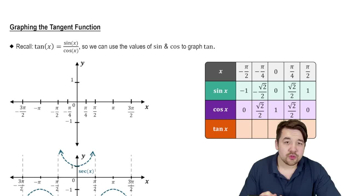Below is a graph of the function . Determine the value of b.
Table of contents
- 0. Functions7h 54m
- Introduction to Functions16m
- Piecewise Functions10m
- Properties of Functions9m
- Common Functions1h 8m
- Transformations5m
- Combining Functions27m
- Exponent rules32m
- Exponential Functions28m
- Logarithmic Functions24m
- Properties of Logarithms36m
- Exponential & Logarithmic Equations35m
- Introduction to Trigonometric Functions38m
- Graphs of Trigonometric Functions44m
- Trigonometric Identities47m
- Inverse Trigonometric Functions48m
- 1. Limits and Continuity2h 2m
- 2. Intro to Derivatives1h 33m
- 3. Techniques of Differentiation3h 18m
- 4. Applications of Derivatives2h 38m
- 5. Graphical Applications of Derivatives6h 2m
- 6. Derivatives of Inverse, Exponential, & Logarithmic Functions2h 37m
- 7. Antiderivatives & Indefinite Integrals1h 26m
- 8. Definite Integrals4h 44m
- 9. Graphical Applications of Integrals2h 27m
- 10. Physics Applications of Integrals 3h 16m
- 11. Integrals of Inverse, Exponential, & Logarithmic Functions2h 31m
- 12. Techniques of Integration7h 41m
- 13. Intro to Differential Equations2h 55m
- 14. Sequences & Series5h 36m
- 15. Power Series2h 19m
- 16. Parametric Equations & Polar Coordinates7h 58m
0. Functions
Graphs of Trigonometric Functions
Problem 99
Textbook Question
Identify the amplitude and period of the following functions.
q(x)=3.6cos(24πx)
 Verified step by step guidance
Verified step by step guidance1
The function given is q(x) = 3.6 \cos\left(\frac{\pi x}{24}\right). This is a cosine function of the form a \cos(bx), where 'a' is the amplitude and 'b' affects the period.
Identify the amplitude: In the function q(x) = 3.6 \cos\left(\frac{\pi x}{24}\right), the coefficient 'a' in front of the cosine function is 3.6. Therefore, the amplitude is 3.6.
Determine the period: The period of a cosine function a \cos(bx) is given by \frac{2\pi}{b}.
In the function q(x) = 3.6 \cos\left(\frac{\pi x}{24}\right), the value of 'b' is \frac{\pi}{24}.
Calculate the period using the formula: Substitute b = \frac{\pi}{24} into the period formula \frac{2\pi}{b} to find the period of the function.
 Verified video answer for a similar problem:
Verified video answer for a similar problem:This video solution was recommended by our tutors as helpful for the problem above
Video duration:
3mPlay a video:
Was this helpful?
Key Concepts
Here are the essential concepts you must grasp in order to answer the question correctly.
Amplitude
Amplitude refers to the maximum distance a wave reaches from its central position, which in the context of a cosine function is the coefficient in front of the cosine term. For the function q(x) = 3.6cos(πx/24), the amplitude is 3.6, indicating that the function oscillates between 3.6 and -3.6.
Recommended video:

Introduction to Cotangent Graph Example 1
Period
The period of a function describes the length of one complete cycle of the wave. For a cosine function of the form cos(kx), the period can be calculated using the formula P = 2π/k. In this case, k is π/24, leading to a period of P = 2π/(π/24) = 48, meaning the function completes one full cycle every 48 units along the x-axis.
Recommended video:

Introduction to Tangent Graph
Cosine Function
The cosine function is a fundamental trigonometric function that describes the relationship between the angle and the lengths of the sides of a right triangle. It is periodic, oscillating between -1 and 1, and is often used to model wave-like phenomena. In the given function, the cosine term dictates the shape and behavior of the wave, influenced by its amplitude and period.
Recommended video:

Graph of Sine and Cosine Function

 5:53m
5:53mWatch next
Master Graph of Sine and Cosine Function with a bite sized video explanation from Patrick
Start learningRelated Videos
Related Practice
Multiple Choice
